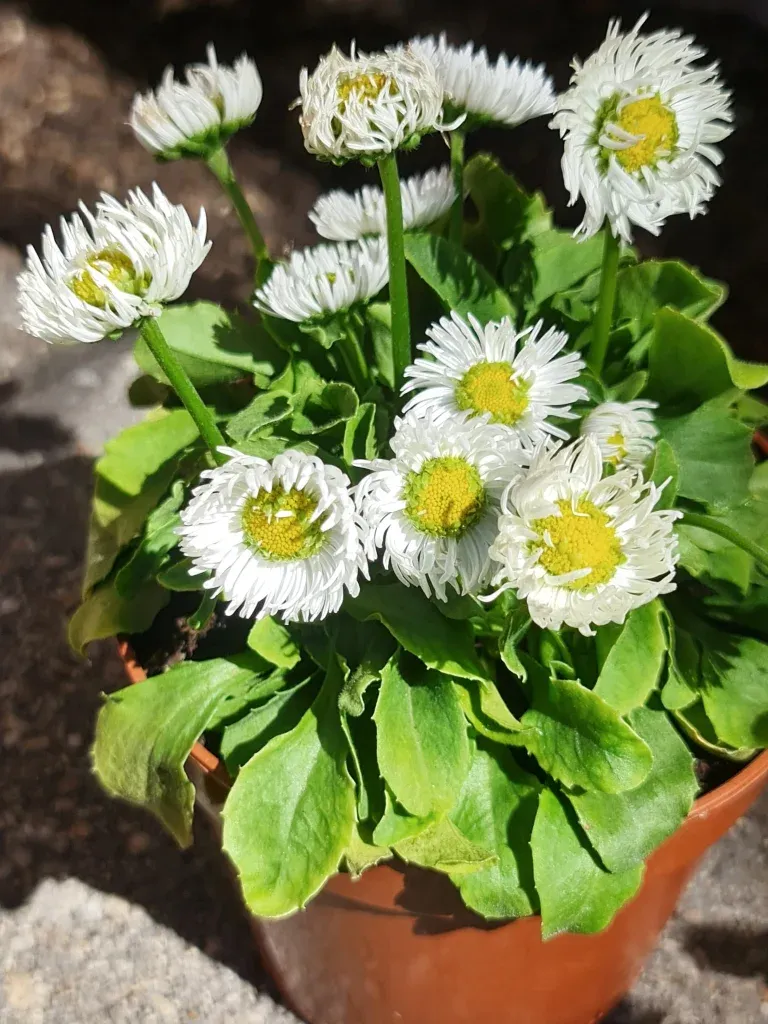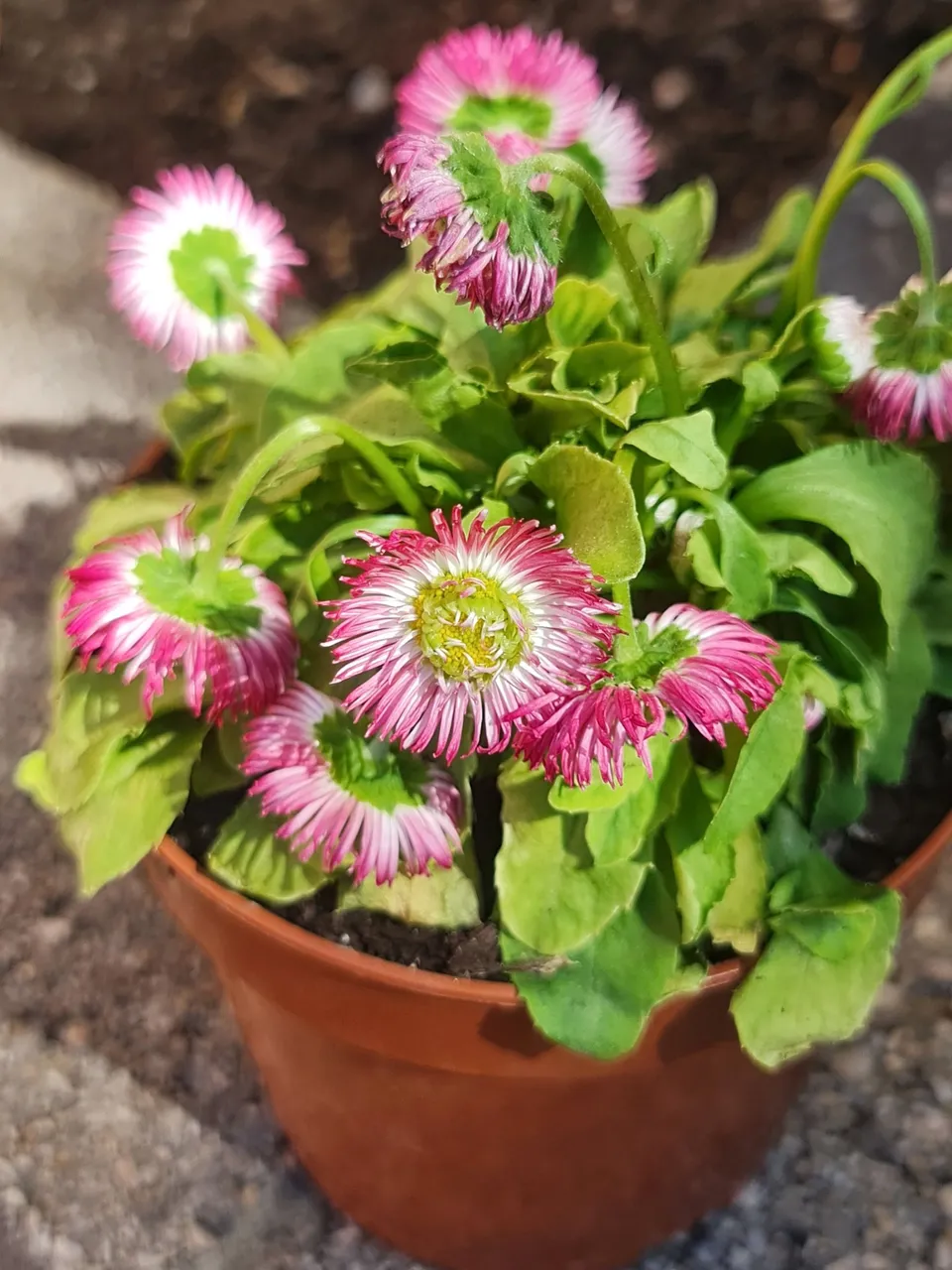Recently, I published a post on the joys of English Daisies as an herbal remedy for some ailments. I got a little more interested and went on and compiled a full monograph on this wonderful plant, which I present to you now.
Common names: English Daisy, Common Daisy, Bruisewort, Lawn Daisy
Taxonomic name: Bellis perennis
Family: Asteraceae
Related herbs: Ox Eye Daisy
Area of origin:
Parts used: the whole plant can be used
Can be medicinally used for: external wounds, arthritic conditions, gout, skin conditions, coughs and colds, varicose veins, hemorrhoids, eczema
Healing Actions: astringent, expectorant, antitussive, vulnerary, diuretic
Taste: bitter, sour
Tissue states: heat, excitation
Energetics: cooling, drying,
Healing constituents: saponins, resin, mucilage, essential oil, vitamin C, bitters
Warnings: some folks are allergic to Daisies and would probably be allergic to these.

Description
Bellis perennis (I like the botanical name so much more than any other) is a perennial that grows from short rhizomes bit it is the flower that we grow it for as gardeners. The flower comes in the second year, just after Summer when there have been a few cool days. Those in the garden centres now have been induced with a little artificial cooling but they'll grow just as well in your garden.
The old name for English Daisies is ‘Bruisewort’. The ‘wort’ part of many herb names that you see is from the old language and means just ‘plant’. Bruisewort, is then a plant that excels at healing bruises. Our common names for it – ‘Common Daisy’ or ‘English Daisy’ don’t sound nearly as good. 'Bellum' is also Latin for ‘war’, so it could have gotten its botanic name from the Romans.
British history tells us that, during the invasion of Britain, the Roman army would send out slaves to harvest Bruisewort by the tonne (or whatever measurement they used back then). Injured soldiers would be treated with Bruisewort for many of their injuries, some of which, often coming from swords, were considerable. I wonder if the slaves received the same medical treatment? English daisies were brought to Australia during the British invasion and subsequent colonisation. There are many members of the Daisy family growing in natively Australia, so Bellis perennis didn't have any difficulty adjusting – I’m surprised that it isn’t far more ‘weedy’ than it is.
Medicinal use
Wounds of all sorts can benefit from Bellis, I wonder if Achilles had found some Bruisewort during the battle of Troy, would he have used it instead of Yarrow. Would the botanic name for Yarrow, 'Achillea', then be applied to this daisy?
In addition to wounds, its astringent juice can be used to tighten up lax blood vessels as in the cases of varicose veins and hemorrhoids . In the same manner it can be used for red noses from either Acne Rosacea or long term overindulgence in alcohol (especially Port). On the theme of Port, Bellis has been used for relieving the pain of arthritis and gout, interestingly, both are aggravated by drinking Port! Its mild astringency makes it ideal for use in eye lotions and skin toners and for treatment of Eczema, especially the weeping sort. of. Burns can benefit from the application of Bellis juice and slow to heal external ulcers also improve with its application.
Coughs and colds are another group of ailments benefitted by Bellis perennis. The saponins in it are slightly irritating to the stomach and cause expectoration from the upper respiratory tract through a reflex action via a shared nerve. I wish I had some around now that I have my first cold of the season to try it out but my plants are all too young to harvest at the moment.
Preparing and using Bellis perennis
To use Bellis as an herb, we crush its leaves and apply the juice directly to wounds. It excels at treating bruises (as its old name suggests) – for that, a poultice of the crushed plant works nicely. Bellis, as a bruise healer, has several big advantages over the other herb commonly used for that type of injury – Arnica. First, Bellis is easy to grow here in South Oz and pretty well everywhere else in the world apparently. I don’t know of anybody growing Arnica in any of my Australian circles of friends. The second benefit that Bellis has for us is that it can be applied directly to open wounds. That’s a great advantage because Arnica is toxic if it gets into the bloodstream or is digested in any but Homeopathic doses.
You can use any part of a Bellis perennis plant herbally but the most common parts used are the leaves and flowers. I’m using the juice from the leaves at the moment, as the flowers have just started and I want to enjoy them for a little while – they’re be plenty of them in a while. As the season progresses, I’ll experiment with making a succus and tincture so that I can store it for a while and I want to make a Bellis salve and a Bellis flower essence too . Of course, I’ll post about each of those as I make and try them.

Some of you may have seen that I've been writing a series of posts about herbs and making herbal remedies at home. I want to share what I know of this topic so that, as the world gets crazier, folks will have other avenues of medical care, namely those of themselves and their community. If you look back over this blog, you can see heaps of info on the topic, plus loads and loads of posts on herbs and using Australian bushfoods from a white perspective. If you haven't been around on in the @hivegarden and @naturalmedicine communities for long, you may be interested in looking back. There's w-a-a-a-a-y too much there for me to repost and the Hive system doesn't let you vote on old posts so, if you're happy with what you find, I believe that there is now a tip option...





